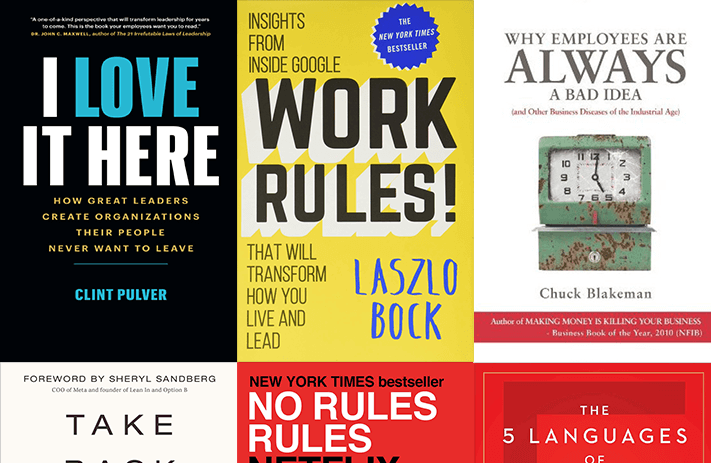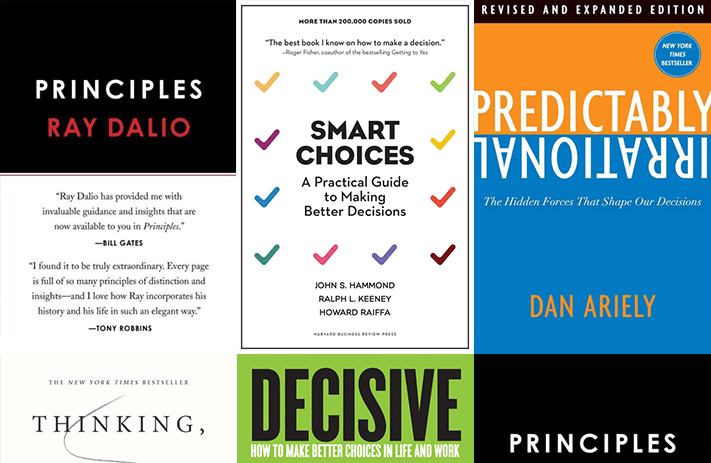
Click the button to start reading
Upgrade Your Workflow: The Best Trello Alternatives for 2023
Project management can be a real challenge, especially when you have a lot of tasks and team members to juggle. Trello has become a popular tool among businesses of all sizes for helping to popularize Kanban boards and because it’s free to start using.
It’s easy to use and doesn’t require any prolonged onboarding pain, which can be frustrating when you’re leading a dynamic team.
But let’s face it, Trello isn’t perfect.
It’s great for basic project management, but it falls short when it comes to more complex projects, and project teams outgrow the program. To compensate for some of its shortcomings, Trello offers integrations with other tools, but relying too heavily on them can be a hassle (and not to mention more costly).
Plus, Trello’s reporting capabilities aren’t as comprehensive as they could be, which can make it tough to get the insights you need to make informed decisions.
If you’ve outgrown Trello or are looking for software that can replace more of your tech stack, there are some great alternatives available.
In this guide, we’ll show you some of the best Trello alternatives online. We’ll walk you through their unique features and benefits and help you figure out which one is best for you and your team.
So, whether you’re a small business owner, a project manager, or an entrepreneur looking for a better way to manage your projects, keep reading!
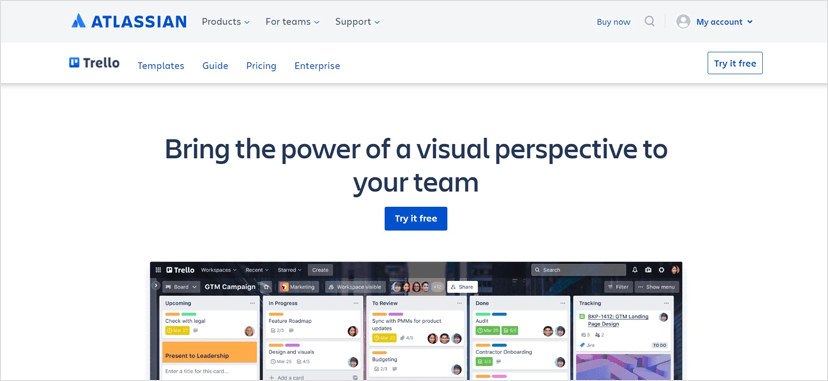
What to Look For In A Trello Alternative
When it comes to project management tools, there’s no shortage of options.
Advancements in technology and internet services have led to significant investment in creating project management software that can boost productivity, cut costs, and unite teams.
But with so many choices out there, how do you know which one is right for you and your team?
Here are some key factors to consider when looking for a Trello alternative:
- Features: The first thing to consider is what features you need to manage your projects effectively. For example, if you have a large team, a tool that helps facilitate collaboration and communication may be needed. More complex projects with many dependencies may benefit from a tool that offers advanced project planning and scheduling features. And if you’re managing a lot of tasks, you’ll want a tool that makes it easy to organize and prioritize them. Make a list of the features that are most important to you and your team, and use that as a guide when evaluating different tools.
- Ease of use: A project management tool should make your life easier, not harder. Trello is an excellent example of this, and moving to something less accessible can cause a bottleneck in progress. The reality is that a simple interface like Trello doesn’t require a lot of training. Ideally, you should be able to start using the tool right away, without having to spend a lot of time learning how it works. Consider how much time and effort you’re willing to invest in learning a new tool, and choose one that fits your level of expertise.
- Integrations: While you don’t want to rely too heavily on integrations, it’s important to choose a tool that integrates well with other tools you’re already using. For example, if you use Slack for team communication, you’ll want a project management tool that can integrate with Slack. This can help streamline your workflow and reduce the need to switch between different tools. Look for tools offering a wide range of integrations or an open API allowing you to build your own integrations.
- Pricing: Of course, pricing is always a factor. Look for a tool that fits within your budget, but don’t sacrifice important features for a lower price. Some tools offer a free plan with limited features and a range of paid plans with different levels of functionality. Consider how many people will be using the tool and whether you’ll need to upgrade to a paid plan to access all the features you need.
Keep in mind that there’s no one-size-fits-all solution for project management, each business and team will have different needs, and the software they use should reflect that.
With the right tool in hand, you’ll be well-equipped to manage your projects and have synergy running through your teams.
Best Trello Alternatives in 2023 for Project Management
Now that we’ve discussed the key factors to consider when looking for a Trello alternative, it’s time to explore some of the best options out there. While Trello is a popular project management tool, it’s not perfect, and there may be other tools that better suit your needs.
Whether you’re looking for more advanced features, better reporting capabilities, or simply a change of pace, there are plenty of alternatives to choose from.
After careful research and consideration, we’ve compiled a list of our top picks for the best Trello alternatives in 2023.
Each of these tools offers something unique, whether it’s powerful project planning and scheduling features, robust reporting capabilities, or seamless integration with other tools.
So without further ado, let’s dive in and explore the best Trello alternatives for small to medium-sized businesses and project managers.
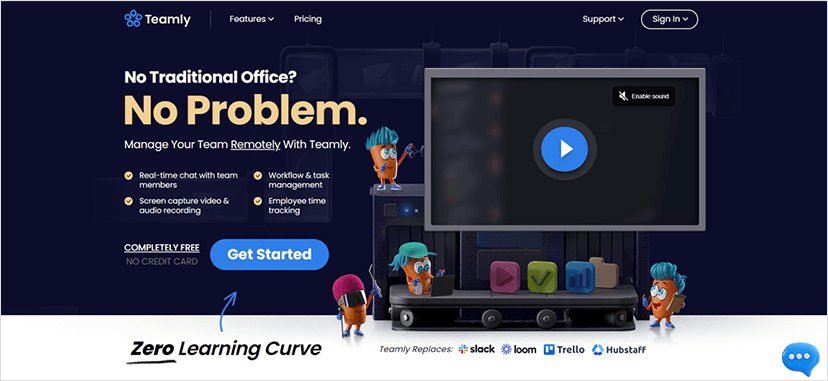
Teamly (best for remote teams)
Teamly is a promising new addition to the world of project management tools, designed specifically with remote teams in mind. It may be the new kid on the block, but we’re confident you’re going to love it.
Unlike some of the more complex project management tools out there, Teamly has a short learning curve, meaning your team and any workers coming on board will be able to get straight to work without sitting through any long onboarding courses.
Teamly’s Kanban boards make task management as simple as dragging and dropping cards across columns, allowing teams to easily track the progress of their work and stay organized. With no-code automation, your team can eliminate any time-consuming, repetitive work, so they can stay focused on the bigger picture.
Since Teamly has been created to ease the suffering of remote teams, there are plenty of features to take advantage of. Collaboration is at the heart of the software so that any amount of distance between employees won’t slow down project progress.
The platform includes built-in team chat functionality, allowing team members to communicate in real-time, no matter where they are in the world. Additionally, Teamly offers time-tracking capabilities, which can be helpful for remote teams that need to keep track of their work hours.
Another benefit of Teamly is its done-for-you templates. These templates can help your team get started quickly and easily on new projects without the need to reinvent the wheel every time.
Plus, if there’s a feature you’d like to see added to the platform, Teamly welcomes feedback and feature requests from its users. We’re building this for you, and our commitment to making project management more accessible for everyone has no limits.
Best of all, Teamly offers an entirely free plan to get started, with the option to upgrade to a paid plan as needed. This means you can try out the platform for yourself and see if it meets your team’s needs without committing to a paid upfront subscription.
Try us out – we’re not just for remote teams!
The features we’ve added to Teamly will benefit all kinds of businesses. Whether you’re a plucky startup or a large enterprise, Teamly’s flexible platform can be tailored to suit your unique needs.
Teamly features
Instead of building out your tech stack with all kinds of different software, Teamly has the features to reduce the number of subscriptions needed. Here are some of the key features included with Teamly:
- Time tracking: Teamly has a built-in timer that tracks time worked down to the second, making it easy to create accurate timesheets and invoices. It also lets you track time spent on client work separately from internal projects.
- Payroll: You can calculate payroll for your team by day, week, month, or a custom date range with just a click. You can also set individual pay rates for each team member and view financial reports for an in-depth look at how labor expenses are allocated.
- Screen recording: With Teamly, you can make screen recordings with audio to explain work assignments, provide feedback, or flip through presentations. You can attach these recordings to task assignments, send them as links or files, and refer back to them whenever you need to recall specific details.
- Custom workflows: Teamly allows you to create customized workflows for your team in minutes, regardless of your size or industry. You can create unlimited workflows and give access to as many users as you like, from remote team members to external partners. Workflows can be used to manage projects, approval processes, marketing campaigns, goals, and more.
Teamly pricing
Teamly offers a free plan that gives you full access to all its features. Yes, you read that right! Unlimited users and up to 5 projects for free. You can try it to see if it fits your team’s needs.
If you need more projects or additional features, Teamly Pro might be perfect for you. It allows for up to 20 projects and has generous user allowances. Plus, you only pay for active users, which makes it scalable and budget-friendly. You can choose between a monthly plan for $9 per user per month or an annual plan for $5 per user per month.
And if your team needs even more projects and user allowances, you can go for the Teamly Business plan. It offers unlimited everything, including projects and user allowances, and also only charges for active users. It comes with a monthly plan for $19 per user per month or an annual plan for $9 per user per month.
So, whatever your team size or budget is, Teamly has a plan for you!
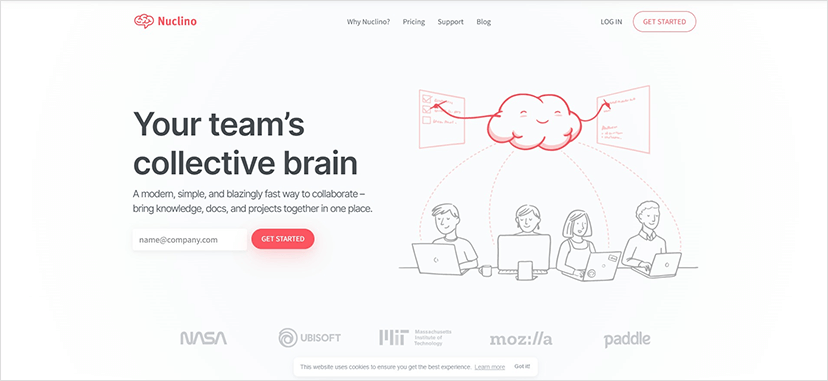
Nuclino (good for content teams)
Nuclino describes itself as ‘your team’s collective brain,’ and that’s a good description of what it does. It’s a workspace where teams can collectively bring all their knowledge, documents, and projects. Designed for teams who need as much synergy as possible, Nuclino is a simple approach to project management.
Nuclino is a great choice for content teams because you can create your work using the editor within the app. You can add anything you need, from text to images and embeds to code blocks, to create stunning pieces of content. Plus, if you’re a fan of Markdown commands, you’ll love how easy it is to write with Nuclino.
Nuclino is also great for real-time collaboration. As soon as someone starts editing a document, changes are visible to everyone else on the team. This makes it easy to collaborate seamlessly and efficiently.
One thing that sets Nuclino apart from other tools is its flexibility. It offers several different views that can be customized to fit any workflow. You can use the List view, which helps to visualize what your team is working on. The Board view manages your projects and tasks, and the Table view makes it easy to filter and organize your data. The Graph view is another visualization tool.
Overall, Nuclino is a powerful tool for teams primarily focused on creating content. With its ability to bring together all your knowledge and projects, its great content creation tools, and its flexible views, Nuclino is an excellent choice for any team looking to streamline its workflow and increase productivity.
Nuclino pricing
- Free tier: 2GB file storage per user, 50 items/documents, and basic email support.
- Standard tier: $5 per user per month annually or $6 monthly. It includes 10GB file storage per user, unlimited items, additional security features like single sign-on and editing restrictions, and priority email support.
- Premium tier: $10 per user per month annually or $6 monthly. It includes 20GB of file storage per user, access to audit logs and team insights, and priority email support.
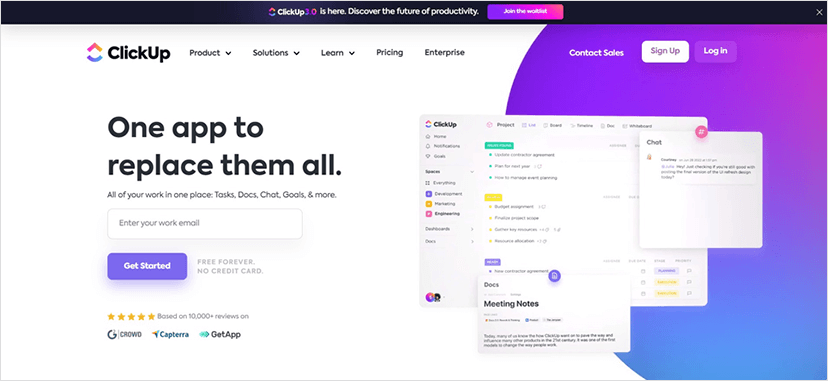
ClickUp (good for customization)
ClickUp is a project management tool that’s known for its extensive customization options. With ClickUp, teams can create custom workflows, track specific data points, and collaborate on tasks and projects in real time.
Here are some of the key features that make ClickUp stand out:
- Customizable dashboards: With ClickUp, you can customize your dashboard to show only the information you need, making it easy to get an overview of your tasks and projects at a glance.
- Custom fields: ClickUp offers a wide range of customizable fields, including text, dropdowns, checkboxes, and more, making it easy to track precisely what you need to.
- Custom statuses: You can also customize your task statuses in ClickUp, so you can track the progress of your tasks in a way that makes sense for your team.
- Custom workflows: ClickUp’s custom workflows allow you to create custom task templates that automatically assign tasks to the right people and move them through your workflow.
- Integrations: ClickUp integrates with a wide range of other tools, including Google Drive, Trello, and Slack, making it easy to keep all your tools in one place.
While ClickUp is a powerful tool, it’s also important to note that it has a steeper learning curve than some other project management tools. This means that it may not be the best option for smaller teams who don’t have a lot of experience with project management software.
ClickUp’s customization options can be a double-edged sword. While they allow you to create workflows and track data in a way that’s tailored to your team’s needs, they can also make it more challenging to get started. New users may need to spend time setting up custom fields, workflows, and dashboards before they can begin to use ClickUp effectively.
If you have the time and resources to invest in learning the platform, ClickUp’s customization options and integrations can help you streamline your workflow and get more done.
ClickUp pricing
- Free: ClickUp offers a free plan that includes unlimited tasks, 100GB of storage, unlimited team members, time-tracking, kanban boards, and 24/7 support.
- Unlimited: ClickUp’s Unlimited plan costs $5 per member per month when paid annually or $9 monthly. This plan includes unlimited storage, integrations, dashboards, email in ClickUp, and agile reporting.
- Business: ClickUp’s Business plan costs $12 per member per month when paid annually or $19 monthly. This plan includes unlimited teams, access to advanced automations, dashboard features, time tracking, and Google single sign-on.
- Business Pro: ClickUp’s Business Pro plan costs $19 per member per month when paid annually or $29 monthly. This plan includes custom role creation, priority support, increased automation, and API access.
- Enterprise: ClickUp offers custom pricing for businesses with large-scale teams, which includes advanced security features, dedicated account management, and custom branding.

Podio (good for developers)
Podio is a project management tool that is especially suited for developers and teams with technical backgrounds. The platform allows users to customize and automate workflows, making it a flexible option for teams with specific needs.
Podio is super flexible and customizable. Developers can create their own custom apps right within the platform. This means that teams can develop apps that are tailored specifically to their needs – whether that’s a bug tracker, project planner, or something totally unique.
With Podio’s app builder, developers can drag and drop fields, set up custom workflows, and even add automation rules.
But don’t worry if you’re not a developer – Podio has got you covered too. They offer a bunch of built-in apps that cover all kinds of different functions, from project management to HR.
You can choose from a library of pre-built apps or you can create your own app from scratch if you’re feeling ambitious.
Either way, you’re sure to find something that works for you.
Some features that make Podio attractive to developers include:
- Customizable workflows: Podio allows users to customize workflows using a drag-and-drop interface, so developers can easily build workflows that match their specific needs.
- Integrations: Podio integrates with a variety of tools, including Excel, Dropbox, and Zapier, making it easy to manage code and track progress.
- Developer API: Podio offers a developer API, which allows developers to build custom integrations and automate workflows even further.
- Advanced reporting: Podio’s reporting capabilities enable users to create custom reports and dashboards that provide insights into project progress, team performance, and more.
- Mobile app: Podio’s mobile app allows developers to access and update projects on the go, so they can stay productive even when they’re away from their desks.
Podio pricing
- Free: Access to task management, apps, and workspaces, but limited to a maximum of 5 employees.
- Plus: $11.20 per employee per month when paid annually or $14 per month. Offers access to more advanced features, such as workflow automation.
- Premium: $19.20 per employee per month when paid annually or $24 per month. Includes access to Podio’s entire suite of advanced features.
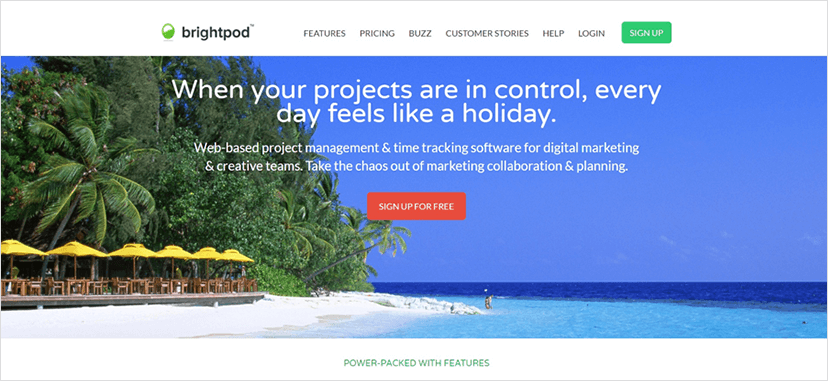
Brightpod (good for marketing teams)
Brightpod is a project management tool that is specifically geared toward marketers and creative teams. With a range of features, including kanban boards, activity logs, time tracking, and reporting, Brightpod is designed to help marketing teams streamline their workflows and improve their productivity.
One of the standout features of Brightpod is its ability to customize the look and feel of the platform. With a range of different themes available, you can tailor your dashboard to suit your personal preferences and branding. This not only makes the platform more visually appealing but also helps to increase user engagement and adoption.
Another great feature of Brightpod is its content calendar, which brings all of your social media marketing efforts directly into the app. This means you can plan, create, and publish content from one central location, saving you time and streamlining your workflow.
In addition to its core features, Brightpod also offers a range of integrations with other popular marketing tools such as Mailchimp, Hootsuite, and Google Analytics. This makes it easy to connect your existing marketing tools and workflows to Brightpod, allowing you to seamlessly incorporate them into your existing workflow.
While Brightpod is a great tool for marketing teams, it may not be the best fit for every team or organization. Its features are specifically tailored to the needs of marketers, so if you’re not in the marketing industry, you may find that some of its features are less relevant to your team’s needs.
That being said, if you’re a marketing team looking for a tool that can help you streamline your workflow, improve collaboration, and increase productivity, then Brightpod is definitely worth considering.
Brightpod pricing
- Professional: This plan costs $29 per month and includes 15 projects, 5 users, and 10 GB of storage. This is an excellent option for small teams or solo marketers who need basic project management tools.
- Studio: The Studio plan costs $59 per month and includes 50 projects, 12 users, and 100 GB of storage. This plan also includes time tracking, insights, and reporting features, making it a good choice for mid-sized marketing teams who need to stay on top of their projects and data.
- Agency: The Agency plan has a free 14-day trial available and costs $99 per month. This plan includes unlimited projects, 25 users, and 250 GB of storage. It also includes time tracking, insights, and reporting features, making it ideal for larger marketing agencies that need to manage multiple projects for multiple clients.
- Agency Plus: The Agency Plus plan is the most comprehensive option and costs $199 per month. It includes unlimited projects, unlimited users, 500 GB of storage, time tracking, insights, and reporting features. In addition, this plan also includes three team training sessions and a dedicated onboarding specialist to help you get started and make the most of the platform.
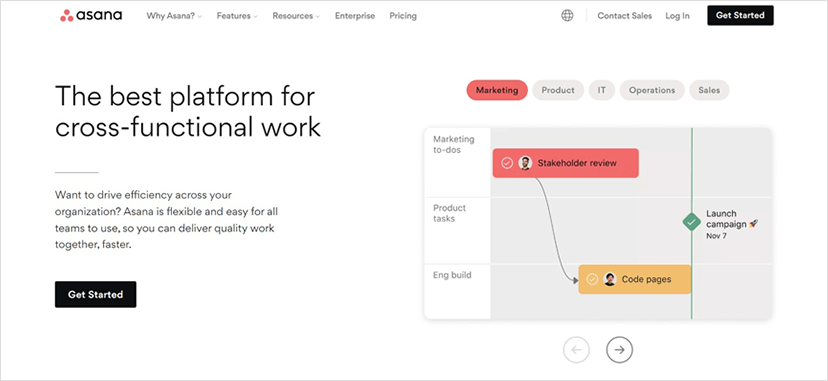
Asana (good for small businesses)
Asana is a project management software that’s particularly well-suited for small businesses. It offers a range of features designed to help teams stay organized, collaborate effectively, and hit their project goals.
Asana’s user-friendly interface and intuitive design make it a popular choice among both tech-savvy and non-technical teams.
One of the most appealing aspects of Asana is its versatility. It can be used for a wide range of projects, from simple to complex, and can scale with your team as you grow. Its customizable features allow you to tailor the platform to meet your specific needs, and its integrations with other tools ensure seamless workflow.
Asana offers several useful features to help small businesses stay organized and productive. For example, it offers project templates that can help teams get started quickly and easily. Its visual project timelines and calendars help keep projects on track and ensure everyone is aware of deadlines. Additionally, Asana’s commenting, and task assignment features facilitate easy collaboration and accountability.
One potential drawback of Asana is its pricing. While it offers a free version, many of its more advanced features are only available with paid plans. However, the free plan can be a great starting point for small businesses that don’t need all the bells and whistles.
Asana pricing
- Free plan: supports up to 10 users, with community support, unlimited board projects, 2GB of storage, and access to reporting and insights.
- Standard plan: costs $7.75 per user per month when paid monthly or $790 per user per year when paid annually. Supports up to 35,000 users, provides 250GB of storage, offers support during business hours, and access to user roles and permissions.
- Premium plan: costs $15.25 per user per month when paid monthly or $1525 per user per year when paid annually. Offers 24/7 premium support, unlimited storage, advanced roadmaps, and access to sandbox and release tracks.
- Enterprise plan: customized pricing for large organizations with bespoke needs. Includes unlimited sites, superior 24/7 enterprise support, and centralized security controls.
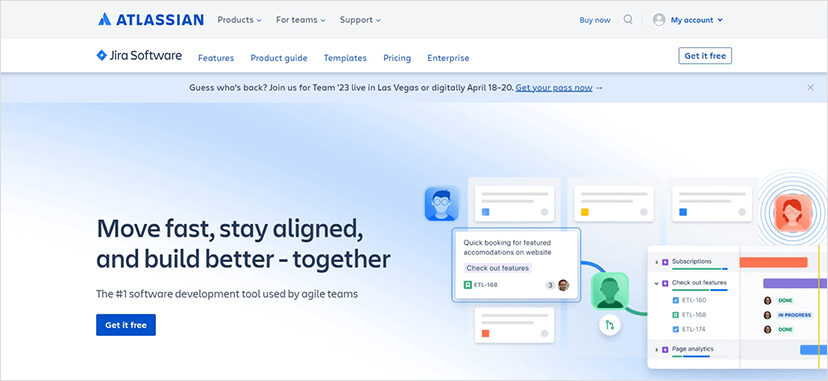
Jira (good for Agile teams)
Jira is a project management tool that is designed for agile teams. Agile is a methodology that emphasizes flexibility, continuous improvement, and rapid iteration. Jira is ideal for software development teams, as it is designed to support agile practices such as Scrum and Kanban.
One of the key benefits of Jira is its flexibility. It allows teams to customize their workflows and processes to suit their specific needs. Jira also provides a range of features that are tailored to agile teams, such as sprint planning, backlog management, and burndown charts.
Among the other benefits of Jira include the following:
- Powerful project management capabilities, including agile methodology support, custom workflows, and issue tracking.
- Integrations with a wide range of tools and services, such as development tools, customer service platforms, and team collaboration software.
- Robust reporting and analytics features that allow teams to track progress, identify bottlenecks, and make data-driven decisions.
- High level of customization, allowing teams to tailor Jira to their specific needs and workflows.
- Large and active user community, providing access to resources, tips, and best practices.
- Atlassian Marketplace, where users can find and install apps to extend Jira’s functionality.
- Cloud-based or self-hosted options provide flexibility for teams with different infrastructure requirements.
- Easy to use interface, making it accessible for teams of all levels of technical expertise.
While Jira is designed for agile teams, it can be used by any team that values flexibility and collaboration. However, it’s important to note that Jira has a steeper learning curve than some other project management tools, so there may be better choices for smaller teams or those with limited experience with agile methodologies.
Jira pricing
- Free: Up to 10 years, only community support available, unlimited board projects, 2GB of storage, and access to reporting and insights.
- Standard: $7.75 per user per month when paid monthly or $790 per user annually. Space for up to 35,000 users. 250GB of storage, support available during business hours, and access to user roles and permissions.
- Premium: $15.25 per user per month when paid monthly or $1525 when paid annually. 24/7 premium support, unlimited storage, advanced roadmaps, and access to sandbox and release tracks.
- Enterprise: Customized pricing for large organizations with bespoke needs. Unlimited sites are included in this package. It provides access to superior 24/7 enterprise support and centralized security controls.
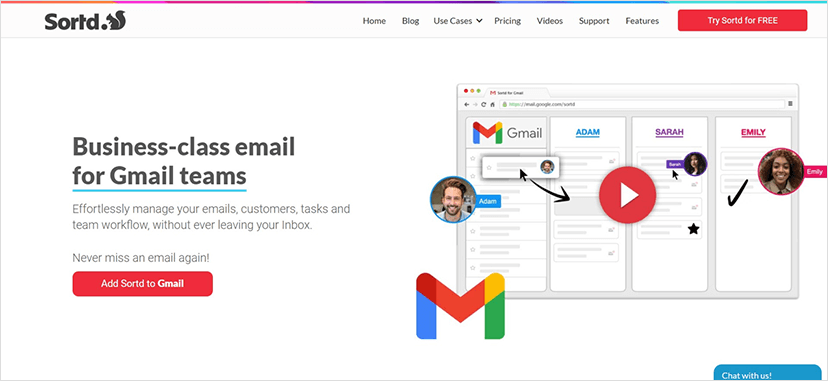
Sortd (good for Gmail teams)
Sortd is a task management and productivity tool designed specifically for Gmail users and teams. With Sortd, teams can manage their tasks, projects, and communication directly from their Gmail inbox.
Here are some of the benefits of using Sortd:
- Integrates seamlessly with Gmail: Since Sortd is built on top of Gmail, it can be used right from within the Gmail interface. This means that users don’t need to switch between multiple apps or tabs to manage their tasks and emails.
- Kanban-style task management: Sortd uses a Kanban board to help users manage their tasks visually. Users can drag and drop tasks between columns to indicate their progress, add due dates, and assign them to team members.
- Customizable columns: Sortd’s Kanban board is highly customizable, allowing users to create columns that match their workflow. Users can also customize the color and icon of each column to make it easier to identify.
- Email to task conversion: With Sortd, users can easily convert their emails into tasks without leaving their inboxes. They can add due dates and tags and assign the task to team members, all from within the email itself.
- Shared inbox: Sortd also allows teams to create a shared inbox where multiple team members can collaborate on emails and tasks. This makes it easier to keep track of communication and ensure that everyone is on the same page.
- Approved by Google: Sortd is an officially approved Gmail add-on, which means that it has undergone a rigorous review process by Google to ensure its compatibility, security, and overall quality.
Sortd is an excellent option for teams that rely heavily on email communication and use Gmail as their primary email client. It offers a simple yet powerful task management system that can help teams stay organized and productive without leaving their inbox.
Sortd pricing
- Starter: Free tier that includes access to email and task management, personal board, day planner, reminders, follow-ups, and email merging. The activity log keeps track of a 30-day history.
- Essential: $8 per user per month when paid annually or $10 when paying monthly. It includes 20 boards, team collaboration, email sharing, email tracking, up to 2 automations, calendar integration, Google Drive uploads, and an activity log that keeps track of 6 months’ history.
- Business: $12 per user per month when paid annually or $15 when paying monthly. It includes unlimited boards, team collaboration, custom fields, automations, and email sharing. Additionally, it offers a team business contact manager, Zapier integrations, and the activity log has an unlimited history.
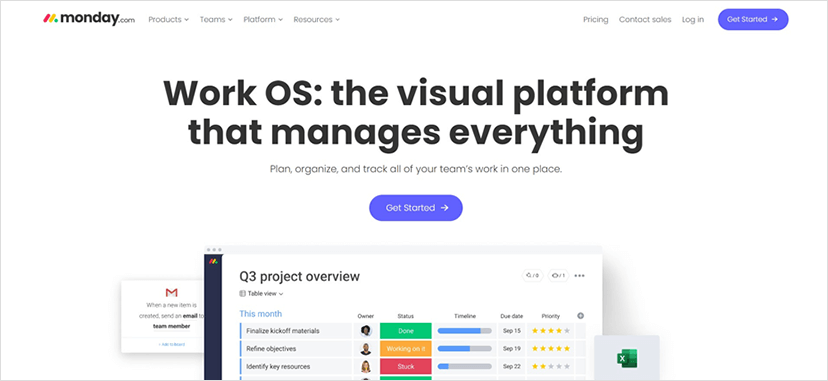
Monday.com (good for integrations)
Monday.com is a popular project management tool known for its powerful integrations with other software tools. It offers a wide range of features, including customizable workflows, project templates, time tracking, team collaboration tools, and more.
Here are some of the key benefits of Monday.com:
- Robust integrations: Monday.com integrates seamlessly with a variety of other software tools, including Google Drive, Trello, Slack, and more. This allows teams to easily connect their workflows and keep everything in one place.
- Customizable workflows: Monday.com’s flexible interface allows users to easily create custom workflows that fit their unique needs. This includes adding custom fields, creating automations, and setting up notifications.
- Project templates: Monday.com offers a library of pre-built templates for a variety of project types, including marketing campaigns, product launches, and more. This allows teams to quickly get started on a new project without having to start from scratch.
- Time tracking: With Monday.com’s time tracking feature, teams can easily track how much time they spend on each task and project. This allows for better project planning and helps teams stay on track.
- Collaboration tools: Monday.com offers a variety of collaboration tools, including file sharing, commenting, and real-time updates. This helps teams stay connected and ensures everyone is on the same page.
- Customizable dashboards: With Monday.com’s customizable dashboards, users can easily create a personalized view of their projects and tasks. This allows for easy tracking of progress and helps users stay focused on what’s important.
- Mobile app: Monday.com has a mobile app that allows users to stay connected and manage their tasks on the go. This makes it easy for team members to stay up-to-date and collaborate, even when not in the office.
- Security: Monday.com takes security seriously and offers a variety of measures to ensure user data is protected. This includes encryption, two-factor authentication, and regular security audits.
While Monday.com is great for teams looking for an all-in-one solution with powerful integrations, the customization options can sometimes feel overwhelming for those who want something out of the box. That being said, the platform’s flexibility is a big selling point for teams who need to adapt their workflows to unique business processes.
Monday.com also offers a number of pre-built templates to help teams get started quickly, even if they don’t have the time or expertise to build out their own workflows from scratch.
Monday.com pricing
- Individual: This is the free tier, which comes with up to 2 seats, up to 3 boards, unlimited docs, over 20 column types, and iOS and Android apps.
- Basic: The Basic plan costs $8 per seat per month when paid annually or $10 when paying monthly. It includes unlimited free viewers, unlimited items, 5 GB file storage, prioritized customer support, and the ability to create a dashboard based on 1 board.
- Standard: The Standard plan costs $10 per seat per month when paid annually or $12 when paying monthly. It includes all Basic features, as well as timeline and Gantt views, calendar view, guest access, 250 automation actions per month, 250 integration actions per month, and the ability to create a dashboard that combines up to 5 boards.
- Pro: The Pro plan costs $16 per seat per month when paid annually or $20 when paying monthly. It includes all Standard features, plus private boards and docs, chart view, time tracking, formula column, dependency column, 25,000 automation actions per month, 25,000 integration actions per month, and the ability to create a dashboard that combines up to 10 boards.
- Enterprise: This plan has bespoke pricing for large organizations and includes enterprise-scale automation and integrations, enterprise-grade security and governance, advanced reporting and analytics, multi-level permissions, tailored onboarding, premium support, and the ability to create a dashboard that combines up to 50 boards.
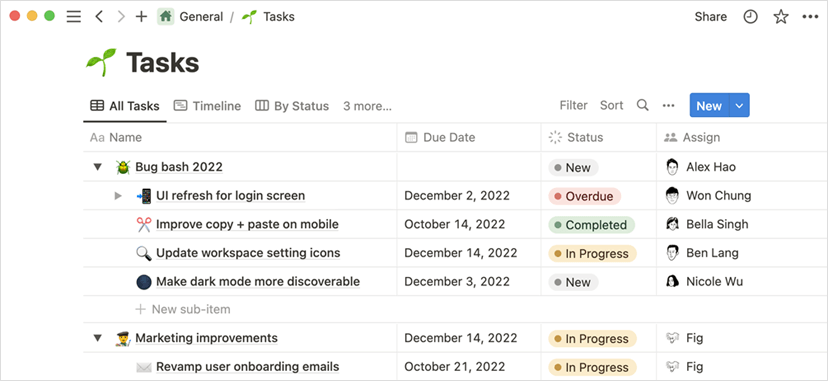
Notion (good for solopreneurs)
Notion is a great tool for solopreneurs for a variety of reasons. One of the main benefits is its flexibility and versatility. Notion can be used for a wide range of tasks and projects, from organizing personal to-do lists and notes to managing business projects and tracking expenses. This makes it a great all-in-one solution for solopreneurs who need to wear many hats and juggle multiple responsibilities.
For example, solopreneurs can use Notion to:
- Create a central hub for all their business information, including to-do lists, notes, and important documents.
- Keep track of project progress and deadlines using Kanban boards, calendars, and timelines.
- Manage customer relationships with Notion’s CRM features.
- Store and organize data using custom databases.
- Create a knowledge base or internal wiki to keep information organized and easily accessible.
Another advantage of Notion is its customizable interface. Users can create their own unique workflows, databases, and dashboards that fit their specific needs and preferences. This level of customization can be particularly helpful for solopreneurs who need to stay organized in a way that works best for them.
Notion’s collaboration features also make it a great tool for solopreneurs who work with others. Users can share pages and databases with clients or contractors, collaborate on projects, and even set up a workspace for a virtual assistant or intern. This allows solopreneurs to maintain control over their work while also collaborating and delegating tasks to others.
Finally, Notion’s affordable pricing and free version make it an accessible option for solopreneurs who may not have a large budget for software tools. The free version offers many basic features and can be a great starting point for solopreneurs who are just getting started or who have a limited budget.
Notion pricing
- Free plan: This is the basic plan that Notion offers, and it’s completely free. It includes access to a collaborative workspace, basic analytics, and unlimited blocks for individuals. You can also invite up to 10 guests to collaborate with you.
- Plus plan: For $8 per user per month on the annual plan or $10 per month when billed monthly, this plan offers unlimited blocks for teams, unlimited file uploads, and 30-day page history. You can invite up to 100 guests to collaborate with you.
- Business plan: For $15 per user per month on the annual plan or $18 per month when billed monthly, this plan provides advanced analytics, 90-day page history, and bulk PDF export. You can invite up to 250 guests to collaborate with you.
- Enterprise plan: This plan offers custom pricing and additional features, including a dedicated success manager, unlimited page history, and advanced security. The guest limit is also customizable to meet the needs of large organizations.
Final Thoughts
Investing in a project management tool to replace Trello is something you’ll only do once in a blue moon (hopefully!). That’s why it’s important to try out the software available to see which ones work best for you and your teams.
After all, you’re going to be building your workflows and relying heavily on the tool – so it needs to be ready to get the job done. With Teamly’s free plan, which gives users access to everything we’ve got, you can be sure we’re the perfect fit before upgrading to a paid plan when your usage increases!
And if one of your users goes inactive, we’ll stop charging you for them, so there’s no wasting money when you choose Teamly.




